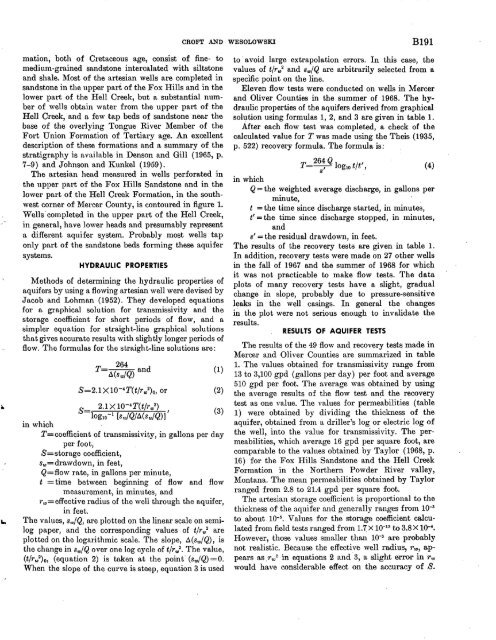RESEARCH· ·1970·
RESEARCH· ·1970·
RESEARCH· ·1970·
Create successful ePaper yourself
Turn your PDF publications into a flip-book with our unique Google optimized e-Paper software.
..<br />
mation, both of Cretaceous age, consist of fine- to<br />
n1edium-grained sandstone intercalated with siltstone<br />
and shale. l\1ost of the artesian wells are completed in<br />
sandstone in the upper part of the Fox Hills and in the<br />
lower part of the I-Iell Creek, but a substantial number<br />
of wells obbtin water from the upper part of the<br />
Hell Creek, ·and a few itap beds of sandstone near the<br />
base of the overlying Tongue River l\1ember of the<br />
Fort Union Formation of Tertiary age. An excellent<br />
description of these formations and a summary of the<br />
stratigraphy is av~tilable in Denson and Gill (1965, p.<br />
7-9) and Johnson and J(unkel ( 1959).<br />
The artesian head measured in wells perforated in<br />
the upper part of the Fox flills Sandstone and in the<br />
lower part of the I-Iell Creek Formation, in the southwest<br />
corner of l\1ercer County, is contoured in figure 1.<br />
Wells· completed in the upper part of the Hell Creek,<br />
in general, have lower heads and presumably represent<br />
n different aquifer system. Probably most wells tap<br />
only part of the sandstone beds forming these aquifer<br />
systems.<br />
HYDRAULIC PROPERTIES·<br />
Methods of determining the hydraulic properties of<br />
aquifers by using a flowing artesian well were devised by<br />
Jacob and Lohman (1952). They developed equations<br />
for a graphical solution for transmissivity and the<br />
storage coefficient for short periods of flow, and a<br />
simpler equation for straight-line graphical solutions<br />
that gives accurate results with slightly longer periods of<br />
flow. The formulas for the straight-line solutions are:<br />
T<br />
264<br />
!l(sw/Q) and<br />
CROFT AND WESOLOWSKI<br />
(1)<br />
S=2.1X10- 4 T(tfrw 2 ) 0 , or (2)<br />
2.1 X 10-<br />
s 4 T(tfrw 2 )<br />
logto -l [sw/Q/!l(sw/Q)] 1 (3)<br />
in which<br />
T=coefficient of transmissivity, in gallons per day<br />
per foot,<br />
S=storage coefficient,<br />
Sw=drawdown, in feet,<br />
Q=flow rate, in gallons per minute,<br />
t =time between beginning of flow and flow<br />
measurement, in minutes, and<br />
7'w=effective radius of the well through the aquifer,<br />
in feet.<br />
The values, Sw/Q, are plotted on the linear scale on semilog<br />
paper, and the corresponding values of tfrw 2 are<br />
plotted on the logarithmic scale. The slope, ll(sw/Q), is<br />
the change in Sw/Q over one log cycle of tfrw 2 • The value,<br />
(tfrw 2 ) 0, (equation 2) is taken at the point' (sw/Q) =0.<br />
When the slope of the curve is steep, equation 3 is used<br />
B191<br />
to · a void large extrapolation errors. In this case, the<br />
values of tfrw 2 and Sw/Q are arbitrarily selected from a<br />
specific point on the line.<br />
Eleven flow tests were conducted on wells in Mercer<br />
and Oliver Counties in the summer of 1968. The hydraulic<br />
properties of the aquifers derived from graphical<br />
solution using formulas 1, 2, and 3 are given in table 1.<br />
After each flow test was completed, a check of the<br />
calculated value for Twas made using the Theis (1935,<br />
p. 522) recovery formula. The formula is:<br />
264Q 1<br />
T=-,- log 10 tjt , ( 4)<br />
8<br />
in which<br />
Q =the weighted average discharge, in gallons per<br />
minute, .<br />
t =the time since discharge started, in minutes,<br />
t' =the time since discharge stopped, in minutes,<br />
and<br />
s' =the residual drawdown, in feet.<br />
The results of the recovery tests are given in table 1.<br />
In addition, recovery tests were made on 27 other wells<br />
in the fall of 1967 and the summer of 1968 for which<br />
it was not practicable to make flow tests. The data<br />
plots of many recovery tests have a slight, gradual<br />
change in slope, probably due to pressure-sensitive<br />
leaks in the well casings. In general the changes<br />
in the plot were not serious enough to invalidate the<br />
results.<br />
RESULTS OF AQUIFER TESTS<br />
The results of the 49 flow and recovery tests made in<br />
l\1ercer and Oliver Counties are summarized in table<br />
1. The values obtained for transmissivity range from<br />
13 to 3,100 gpd (gallons per day) per foot and average<br />
510 gpd per foot. The average was obtained by using<br />
the average results of the flow test an~ the recovery<br />
test as one value. The values for permeabilities (table<br />
1) were obtained by dividing the thickness of the<br />
aquifer, obtained from a driller's log or electric log of<br />
the well, into the value for transmissivity. The permeabilities,<br />
which average 16 gpd per square foot, are<br />
comparable to the values obtained by Taylor (1968, p.<br />
16) for the Fox Hills Sandstone and the Hell Creek<br />
Formation in the Northern Powder River valley,<br />
l\1ontana. The mean permeabilities obtained by Taylor<br />
ranged from 2.8 to 21.4 gpd per square foot.<br />
The. artesian storage coefficient is proportional to the<br />
thickness of the aquifer and generally ranges frmn 10- 3<br />
to about 10- 5 • Values for the storage coefficient calculated<br />
from field tests ranged from 1.r X 10- 13 to 3.8 X lQ- 4 •<br />
However, those values smaller than 10- 5 are probably<br />
not realistic. Because the effective well radius, rw, appears<br />
as .rw 2 in equations 2 and 3, a slight error in rw<br />
would have considerable effect on the accuracy of S.
















